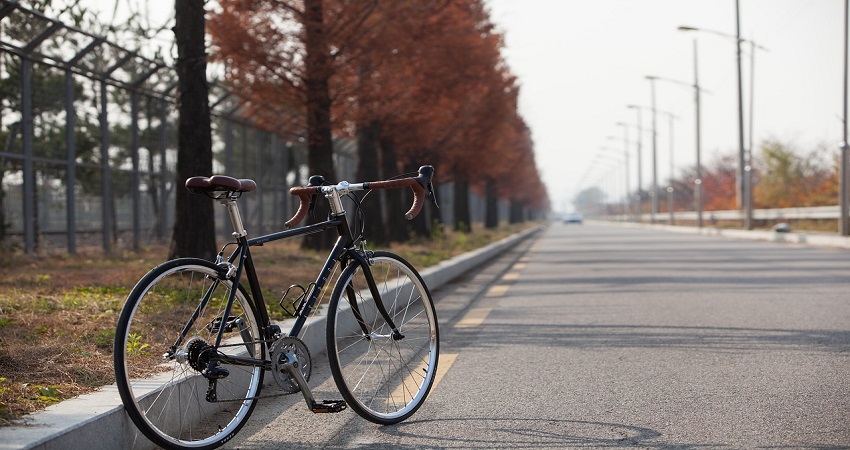The most important component of a road bike is the wheel system as it significantly impacts the cyclist’s performance on the road. The wheel system’s quality and setup directly affect the rider’s power transfer and overall riding experience.
Choosing the right road bike relies heavily on understanding its essential components. While each part plays a crucial role in the bike’s overall performance, the wheel system stands out as the most vital. A well-constructed wheel system not only enhances the bike’s speed and handling but also contributes to the rider’s comfort and efficiency.
With this in mind, cyclists need to prioritize the wheel components when selecting or upgrading their road bikes. Understanding the significance of the wheel system empowers cyclists to make informed decisions when investing in a road bike that aligns with their performance and riding preferences.
Key Components Of A Road Bike
Frame
The frame is the foundation of a road bike, influencing its weight, strength, and ride quality. A quality frame ensures better handling and performance, making it integral to the overall experience.
Wheel System
The wheel system significantly impacts a road bike’s performance, translating the cyclist’s power to the road. High-quality wheels offer better aerodynamics and reduced rolling resistance, enhancing speed and efficiency.
Derailleur System
The derailleur system plays a critical role in shifting gears smoothly and efficiently. Advanced derailleurs facilitate seamless gear changes, optimizing the bike’s adaptability to varying terrains.
Shifter
A responsive and ergonomic shifter contributes to a rider’s comfort and control. Well-designed shifters enable precise and effortless gear shifts, enhancing the overall riding experience.
Brakes
Reliable brakes ensure safety and control during rides. Quality brakes offer responsive stopping power, instilling confidence in the rider and enabling precise speed modulation.
Tires
The importance of top-notch tires cannot be overstated. High-quality tires with superior traction and durability provide stability and performance, crucial for a smooth and safe ride.
Wheel Size And Fit
The proper wheel size and fit contribute to a comfortable and efficient riding experience. Correct wheel size and fit enhance the bike’s maneuverability and the rider’s comfort, optimizing performance and control.
Frame: The Backbone Of A Road Bike
The frame of a road bike is like its backbone, providing the structural support and stability necessary for a smooth and efficient ride. It determines the bike’s overall performance, handling, and durability, making it one of the most crucial components to consider when purchasing a road bike. Let’s explore some key aspects of the frame that significantly impact its quality and performance.
Material Quality
The material used to construct the frame plays a vital role in its overall quality and performance. Road bike frames are typically made from various materials, including aluminum, carbon fiber, and steel. Each material has its unique characteristics, affecting factors such as weight, stiffness, strength, and comfort.
| Material | Characteristics |
|---|---|
| Aluminum | Lightweight, affordable, and provides good stiffness. Though less comfortable than carbon fiber. |
| Carbon Fiber | Extremely lightweight, excellent stiffness-to-weight ratio, absorbs road vibrations for a smoother ride. |
| Steel | Durable, offers a comfortable ride, but generally heavier than aluminum or carbon fiber. |
Weight And Strength Impact
The weight and strength of the frame are crucial factors in determining the bike’s performance and efficiency. A lighter frame allows for easier acceleration, climbing, and maneuvering, enabling riders to maintain higher speeds with less effort. On the other hand, a stiffer frame provides better power transfer from the pedals to the wheels, making the bike more responsive and efficient.
While a lightweight frame is desirable, striking the right balance between weight and strength is essential. An overly light frame may sacrifice durability and compromise its ability to withstand the rigors of the road. Manufacturers use advanced engineering techniques and materials to optimize both weight and strength, ensuring the frame can withstand the forces experienced during intense rides and maintain its longevity.
It’s important to consider your own riding style, preferences, and budget when choosing a road bike frame. Whether you prioritize lightweight construction, superior stiffness, or a comfortable ride, understanding the impact of material quality, weight, and strength will guide you towards selecting the most suitable frame for your needs.
Wheel System: Enhancing Performance
The wheel system is the pivotal component of a road bike, significantly impacting performance. It strongly influences the cyclist’s power and connection to the road. A high-quality wheel system can greatly enhance a rider’s experience and overall biking capabilities.
The wheel system of a road bike plays a crucial role in enhancing its overall performance. It is the component that connects the bike to the ground, providing stability, handling, and speed. A high-quality wheel system can significantly impact the efficiency and comfort of your ride. To truly understand the importance of the wheel system, let’s dive into the significance of quality rims and spokes.
Importance Of Quality Rims
The rims of a road bike are not only responsible for holding the tire in place but also have a significant impact on its overall performance. Quality rims can improve aerodynamics, reduce rolling resistance, and enhance the overall handling of the bike. Choosing rims that are lightweight yet durable can make a noticeable difference in your riding experience.
When it comes to rims, it’s important to consider factors such as material, profile, and width. Carbon fiber rims, for example, are known for their lightweight nature and excellent stiffness. Aluminum rims, on the other hand, offer a balance between weight and affordability.
The profile of the rim, such as deeper or shallower rims, can affect aerodynamics and stability. Additionally, wider rims provide better tire support and allow for lower tire pressures, resulting in improved traction and comfort.
Significance Of Spokes
While often overlooked, the spokes of a road bike are essential for the overall strength and durability of the wheel system. Spokes connect the hub to the rim, providing support and evenly distributing the rider’s weight and forces exerted on the bike. High-quality spokes are crucial for maintaining the tension and integrity of the wheel.
They ensure that the wheel remains true and doesn’t deform under stress, resulting in a smoother and more efficient ride. Additionally, properly tensioned spokes can mitigate the risk of wheel wobbling or coming out of true during your ride.
When choosing spokes, factors such as material, gauge, and lacing pattern should be considered. Stainless steel spokes are commonly used for their durability and resistance to corrosion. Higher gauge spokes offer more strength, while lower gauge spokes provide more compliance and shock absorption. The lacing pattern, such as radial or crossed, can impact the overall stability and strength of the wheel system.
In conclusion, the wheel system of a road bike plays a vital role in enhancing performance. Quality rims and spokes are crucial components that directly impact speed, handling, and overall comfort. Investing in a high-quality wheel system can greatly enhance your riding experience and help you unleash your full potential on the road.
Derailleur System: Smooth Gear Shifting
Experience smooth gear shifting with the derailleur system, a crucial component of a road bike ensuring seamless transitions between gears. Enhancing performance, this mechanism optimizes your cycling experience for efficient rides.
Difference Between Cheap And High-end Bikes
When it comes to road bikes, there is a clear distinction between cheap and high-end models. Let’s explore the key differences that can greatly impact your cycling experience:
The derailleur system is one of the most crucial components of a road bike. Its primary function is to facilitate smooth gear shifting, allowing riders to adjust their cadence according to the terrain and their performance goals. A well-functioning derailleur system ensures seamless transitions between gears, enabling riders to maintain their momentum and maximize their efficiency on the road.
But what sets the derailleur system of a high-end bike apart from that of a cheaper one?
- Quality of Materials: High-end bikes are equipped with top-of-the-line derailleurs, meticulously designed and constructed using premium materials. These derailleurs are lightweight, durable, and precision-engineered to deliver optimum performance in any cycling condition. On the other hand, cheaper bikes usually feature lower-quality derailleurs that may be less efficient and prone to issues such as gear skipping or misalignment.
- Technology and Ergonomics: High-end bikes often employ advanced technologies and innovative designs to enhance the functionality and ergonomics of their derailleur systems. They may feature sophisticated gear shifting mechanisms, such as electronic shifting systems, which offer precise and lightning-fast gear changes with minimal effort. These bikes also prioritize rider comfort by incorporating ergonomic shift levers.
- Precision and Adjustability: High-end derailleur systems are known for their precision and adjustability. Riders can fine-tune their gear indexing, ensuring accurate gear changes without any performance hiccups. This level of customization allows cyclists to optimize their gear shifting for specific riding conditions, such as steep climbs or fast descents.
On the other hand, cheaper bikes tend to have less refined derailleur systems. While they may still offer functionality, they may lack the precision and smoothness of their high-end counterparts.
Inconsistent gear changes and occasional chain slippage can hinder your cycling experience, affecting your speed, cadence, and overall performance.
To summarize, investing in a high-end road bike with a superior derailleur system can significantly improve your cycling experience. The combination of high-quality materials, advanced technology, and precise adjustability ensures smooth gear shifting, allowing you to ride with confidence and efficiency.
Brakes: Ensuring Safety And Control
Types Of Brakes
When it comes to road bikes, one of the most critical components that ensures rider safety and control is the braking system. Different types of brakes are available on road bikes, each with its own set of characteristics and performance.
Impact On Riding Experience
The type of brakes equipped on a road bike can have a significant impact on the overall riding experience. From responsiveness to modulation, the braking system contributes to the rider’s confidence and control.
Tires: Essential For Traction And Stability
Tires are paramount for traction and stability on a road bike, ensuring optimal performance and grip. The right tires can significantly impact overall handling and safety during rides.
Role Of Quality Tires
Quality tires play a crucial role in a road bike’s performance, providing traction and stability on various terrains. They are the only point of contact between the bike and the road, influencing the overall ride quality and handling.
Choosing The Right Tubes
Choosing the right tubes is essential as they directly impact the durability and performance of the tires. Opting for high-quality tubes can prevent punctures and ensure a smooth riding experience.
Size And Fit: Personalized To Maximize Performance
When it comes to road biking, the size and fit of the bike play a pivotal role in determining the overall riding experience and performance. Achieving the right size and fit ensures that the bike is personalized to the rider’s specific body dimensions and biomechanics, ultimately maximizing comfort, efficiency, and power transfer.
Factors To Consider
The size and fit of a road bike are influenced by various factors that can significantly impact the rider’s comfort and performance. It’s essential to consider the following aspects for an optimal biking experience:
- Rider’s Body Measurements
- Bike Geometry
- Flexibility and Riding Style
- Comfort and Handling Preferences
Impact On Riding Comfort
A well-fitted road bike greatly impacts the rider’s comfort during long rides and challenging terrains. Proper sizing and fit contribute to reducing strain on the body, preventing discomfort, and minimizing the risk of injuries. It enhances the overall stability, control, and confidence of the rider, creating an enjoyable and efficient cycling experience.
Frequently Asked Questions
What Is The Most Important Part Of The Road Bike?
The frame is the most important part of a road bike as it affects the bike’s fit, ride quality, and handling.
What Is The Most Important Component On A Bicycle?
The most important component on a bicycle is the frame, influencing fit, ride, and handling performance.
What Is The Most Important Measurement On A Road Bike?
The most important measurement on a road bike is the seat tube length. It determines the bike’s size and affects comfort and performance.
What Should I Look For In A Good Road Bike?
A good road bike should have a lightweight frame, wheels, and components. It should also have a drop handlebar (though some have a flat bar like a mountain bike) and narrow wheels and tires.
Conclusion
When it comes down to it, the most crucial component of a road bike is the wheel system. The strength of a cyclist’s legs and their performance are heavily impacted by the quality of the wheels. So, make sure to prioritize the perfection of your bike’s wheel setup for an optimal riding experience.





